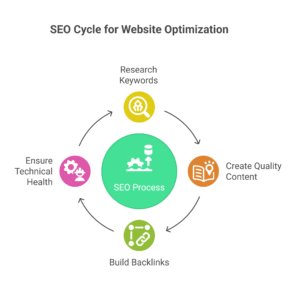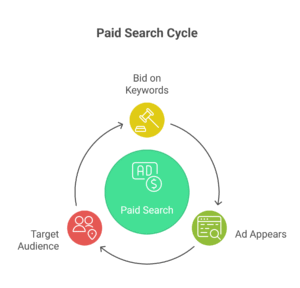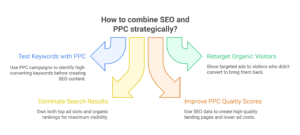If you’ve ever wondered whether to focus your marketing budget on SEO or paid search ads, you’re definitely not alone. It’s one of the biggest decisions businesses face when trying to get more visibility online.
Here’s the thing: both SEO and paid search can drive serious traffic to your website. But they work in completely different ways, cost different amounts, and deliver results on very different timelines.
In this comprehensive guide, we’ll break down everything you need to know about SEO vs. paid search so you can make the smartest choice for your business. Spoiler alert: the best strategy might actually be using both together strategically.
What Is SEO?
SEO (Search Engine Optimization) is about improving your website so it ranks higher on search engines like Google — without paying for ads.
Think of SEO as the art and science of making your website irresistible to search engines. When someone searches for something related to your business, you want your website to show up as high as possible in those “organic” search results.
The beauty of SEO is that once you start ranking well, you can get tons of free traffic flowing to your site. But here’s the catch: it takes time, effort, and a solid strategy to make it work.
How It Works

SEO isn’t magic, but it can feel pretty magical when it starts working. Here’s what goes on behind the scenes:
- Uses keywords to match search intent: You research what your customers are actually searching for, then create content that answers their questions perfectly.
- Focuses on content quality and relevance: Google rewards websites that provide genuine value to users. This means writing helpful, detailed content that people actually want to read.
- Relies on backlinks and technical site health: Other websites linking to yours is like getting votes of confidence. Plus, your site needs to load fast, work on mobile, and be easy for search engines to crawl.
SEO is like planting a garden. You put in the work upfront, tend to it regularly, and eventually, you’ll have a beautiful, thriving source of organic traffic that keeps growing over time.
What Is Paid Search?
Paid Search (PPC) lets you show ads at the top of Google or other search engines — and you pay each time someone clicks.
With paid search, you’re essentially buying your way to the top of search results. Instead of waiting months for SEO to kick in, you can start getting traffic literally within hours of setting up your first campaign.
The trade-off? You’re paying for every single visitor that comes to your site through these ads. The moment you stop paying, the traffic stops flowing.
How It Works

Paid search operates on an auction system that happens in milliseconds every time someone searches:
- You bid on keywords in Google Ads or Bing: You tell Google how much you’re willing to pay when someone searches for specific terms related to your business.
- Your ad appears instantly in search results: If your bid is competitive and your ad is relevant, Google will show it to searchers right away.
- You can target by device, location, audience, time, etc.: Want to only show ads to people in Chicago on weekdays between 9 AM and 5 PM? You can do that.
Paid search is like having a faucet you can turn on and off. Need more leads this month? Increase your budget. Slow season coming up? Scale back your spending.
Where Each Appears on Search Results
Understanding where your content shows up on search engine results pages (SERPs) is crucial for setting expectations:
- Paid search ads show at the top and bottom of search result pages: These spots are clearly marked as “Ad” or “Sponsored” but they get prime real estate at the very top of the page.
- SEO results appear in the organic listings: These show up typically below the ads in the main body of search results. While they don’t get the top spots, many users trust organic results more than ads.
Here’s something interesting: studies show that the top organic result gets about 28.5% of clicks, while the top paid ad gets around 2-5%. But here’s the kicker – paid ads appear before organic results, so they get seen first.
The key takeaway? Both positions have their advantages. Paid ads get immediate visibility, while organic results earn more trust and clicks when they rank well.
SEO vs. Paid Search: Pros and Cons
Let’s get into the nitty-gritty of what makes each strategy shine, and where they fall short.
SEO Pros
- Free traffic: Once you rank, you don’t pay for each click. A single blog post that ranks well can drive thousands of visitors without any ongoing ad spend.
- Builds long-term authority: High-ranking content establishes your business as a trusted expert in your field. This credibility extends beyond just search engines.
- Better for trust and brand awareness: Many users skip right past ads to find organic results. When you rank organically, people see you as more credible and trustworthy.
- Higher click-through rates: Organic results receive 8.5x more clicks than paid ads.
SEO also has some hidden benefits. It forces you to create valuable content, which helps with email marketing, social media, and sales conversations. Plus, the research you do for SEO often reveals insights about your customers that help with all your marketing efforts.
SEO Cons
- Slow results: Most SEO efforts take 3-6 months to show meaningful results, and sometimes much longer for competitive keywords.
- Ongoing effort needed: SEO isn’t “set it and forget it.” You need to consistently create content, build links, and optimize your site to maintain and improve rankings.
- Algorithm updates can impact rankings: Google changes its algorithm hundreds of times per year. A major update could potentially hurt your rankings overnight, though this is less common with white-hat SEO practices.
- No guaranteed results: Only 0.63% of Google searchers click on results from the second page according to Backlinko’s analysis.
PPC Pros
- Fast results: You can have ads running and traffic flowing to your site within a few hours of setting up a campaign.
- Laser-focused targeting: Want to target 35-year-old homeowners in specific zip codes who searched for your exact service last week? PPC can do that.
- Data-driven and easy to test: You can test different headlines, descriptions, and landing pages quickly to see what converts best. The data is immediate and actionable.
- Budget control: You set exactly how much you want to spend daily, weekly, or monthly.
PPC also gives you complete control over your messaging and timing. Launching a new product? Running a sale? You can have targeted ads up immediately to drive traffic exactly when you need it.
PPC Cons
- Can get expensive: Popular keywords in competitive industries can cost $50+ per click. If you’re not converting well, costs can spiral quickly.
- Traffic stops when budget runs out: The moment you pause your campaigns or hit your daily budget limit, the traffic stops. There’s no residual effect.
- Lower trust compared to organic listings: Some users actively avoid ads, and others simply trust organic results more. You might miss out on these potential customers.
- Click fraud concerns: An estimated 11% of paid search clicks are fraudulent.
Cost Comparison: SEO vs. Paid Search
Money talks, so let’s break down what you can expect to invest in each strategy:
| Factor | SEO | Paid Search |
|---|---|---|
| Initial Cost | Low to Medium (mostly time or agency cost) | High (ad spend + management fees) |
| Ongoing Cost | Content, links, technical upkeep | Continuous bid and budget management |
| Top ROI Timeline | 3–6 months or more | Immediate |
| Average Monthly Investment | $2,000-$10,000+ (agency) | $1,000-$50,000+ (ad spend) |
Here’s what these costs look like in real numbers:
SEO Investment: If you’re doing it yourself, you’re mainly investing time – lots of it. Hiring an agency typically costs $2,000-$10,000+ per month depending on your market and goals. The upfront investment might feel steep, but successful SEO campaigns often pay for themselves many times over in the long run.
PPC Investment: You’ll pay for ad spend plus management costs. Small businesses might start with $1,000-$3,000 per month in ad spend, while larger companies can easily spend $50,000+ monthly. Management fees typically range from 10-20% of ad spend if you’re working with an agency.
The key difference is cash flow timing. SEO requires patience – you invest money upfront and wait for returns. PPC can deliver immediate returns, but the costs are ongoing and can add up quickly.
Performance Benchmarks: ROI & Conversion Rates
Let’s talk numbers that really matter – return on investment and conversion rates:
- Average SEO ROI: 275%–600% over 12+ months according to FirstPageSage research
- Average Google Ads conversion rate: 3.75% for Search campaigns per WordStream 2025 benchmarks
- SEO conversion rate: 2.4%–5.2% depending on industry based on HubSpot’s analysis
- SEO leads cost 61% less than outbound leads according to HubSpot’s State of Inbound report
These numbers tell an interesting story. SEO typically delivers higher long-term ROI, but it takes time to get there. PPC can be profitable from day one if managed properly, but the ROI usually levels off unless you’re constantly optimizing.
Here’s something most people don’t realize: the best-performing businesses often see higher conversion rates from organic traffic than paid traffic. Why? Because organic visitors often have higher intent and trust levels.
However, these benchmarks vary wildly by industry. A local plumber might see 10%+ conversion rates from both SEO and PPC, while a SaaS company might be thrilled with 2-3%. The key is understanding what’s normal for your specific business and market.
Is It Better to Use SEO or Paid Search?
This is the million-dollar question, and the answer isn’t as simple as picking one or the other.
Situational Use Cases
Here’s when each strategy makes the most sense:
- Use SEO if: You want long-term traffic, brand authority, and lower costs over time. SEO is perfect for businesses that can invest in the future and wait for results. It’s also ideal if you’re in a niche where you can realistically compete for rankings.
- Use PPC if: You need fast results, leads now, or want to promote a limited-time offer. PPC is essential for new businesses that need immediate visibility, seasonal businesses, or anyone testing new markets or products.
But here’s what successful businesses know: this doesn’t have to be an either/or decision.
“The most successful companies don’t choose between SEO and PPC. They use both strategically to dominate search results.” – Barry Schwartz, Search Engine Roundtable
Combine for Best Results
Using both together helps you cover all bases — quick wins from PPC while SEO builds long-term traffic.
Think about it this way: PPC gives you immediate feedback about what keywords and messages work, while SEO builds the foundation for sustainable, long-term growth. When you use them together, they actually make each other more effective.
Companies using both SEO and PPC together see 25% more clicks and 27% more profits than those using either alone.
How to Combine SEO & Paid Search Strategically

Here’s where things get really interesting. When you use SEO and PPC together, the whole becomes greater than the sum of its parts:
- Use PPC to test keywords before building SEO content: Why spend months creating content for keywords that don’t convert? Run PPC campaigns first to identify your highest-converting terms, then build SEO content around those winners.
- Retarget organic visitors with paid ads: Someone visited your blog post but didn’t convert? Show them targeted ads as they browse other sites to bring them back when they’re ready to buy.
- Own both top ad slots and top organic rankings for max visibility: When you dominate both paid and organic results for important keywords, you push competitors off the first page and capture more total clicks.
- Use SEO data to improve PPC Quality Scores: High-quality landing pages based on your SEO content can improve your ad relevance and lower costs.
Here’s a strategy most businesses miss: use your organic content to improve your PPC Quality Scores. When your ads lead to high-quality, relevant landing pages (like your SEO-optimized content), Google rewards you with lower costs and better ad positions.
Another powerful approach: identify keywords where you rank on page 2 or 3 organically, then run PPC campaigns for those terms while you work to improve your organic rankings. This way, you’re still capturing traffic while your SEO efforts catch up.
Emerging Trends You Need to Know
The search landscape is evolving fast, and staying ahead of these trends could give you a major competitive advantage.
AI & SEO
- Use AI tools (like ChatGPT) to scale content and keyword research: AI can help you generate content ideas, optimize existing content, and identify keyword opportunities faster than ever before.
- Google’s Search Generative Experience may change how people find answers: As AI-powered search features roll out, the way people interact with search results is changing. This could impact both organic and paid strategies.
- AI-powered content optimization: Tools like SurferSEO and MarketMuse are using AI to help create more relevant, comprehensive content.
Search Personalization
- Search results are increasingly personalized by user behavior and location: Two people searching for the same term might see completely different results based on their search history, location, and preferences.
- PPC can offer more control with audience targeting: While you can’t control how Google personalizes organic results, you can precisely target your ideal customers with paid ads.
- Zero-click searches are increasing: Nearly 65% of Google searches end without a click to another website.
Mobile-First Behavior
- Over 60% of searches now come from smartphones: This isn’t just about having a mobile-friendly website anymore – it’s about designing experiences specifically for mobile users.
- Make sure your SEO and landing pages are designed for mobile: Page speed, easy navigation, and thumb-friendly design are crucial for both organic rankings and PPC conversion rates.
- Voice search optimization: 27% of the global online population is using voice search on mobile.
Tips for Choosing the Right Strategy
Here’s a practical framework for making the decision that’s right for your business:
- Set clear business goals (leads, traffic, sales): Are you trying to build long-term brand awareness or do you need leads this quarter? Your timeline and goals should drive your strategy.
- Estimate your budget and resources: Be honest about what you can afford and sustain. A small PPC budget might deliver better results than a half-hearted SEO effort.
- Analyze how competitive your keywords are: If you’re competing against established brands with massive SEO budgets, PPC might be your best bet for getting immediate visibility.
- Use tools like Google Keyword Planner or SEMrush: Research keyword difficulty and PPC costs to understand what you’re up against in both channels.
- Consider your industry’s search behavior: B2B buyers often research extensively (favoring SEO), while impulse purchases might convert better with PPC.
Start by asking yourself these questions: How quickly do I need results? What’s my monthly marketing budget? Do I have someone who can manage SEO or PPC effectively? Am I in a competitive market? Your answers will point you toward the right strategy.
Final Thoughts
SEO and Paid Search aren’t enemies — they work best together. Use SEO for long-term traction and credibility, and PPC for speed and precision. With the right mix, you’ll dominate the search results from both sides.
The most successful businesses don’t see this as an either/or decision. They understand that SEO and PPC serve different purposes and complement each other beautifully when used strategically.
If you’re just starting out and can only choose one, consider your timeline and budget. Need results fast? Start with PPC. Have patience and want to build something sustainable? Begin with SEO. But as soon as you can, start incorporating both into your marketing strategy.
Remember, the best digital marketing strategy is the one you can execute consistently and measure effectively. Whether that’s SEO, PPC, or both, focus on doing it well rather than trying to do everything at once.


